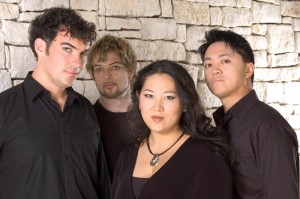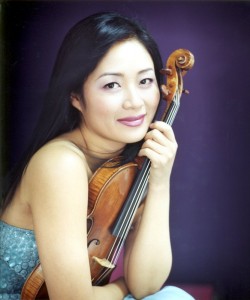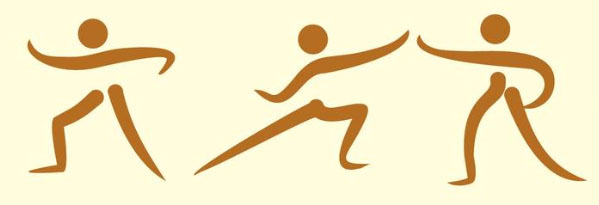Masterworks Unlimited, the Orcas Island Chamber Music Festival concerts this Friday and Saturday, brings back two rising stars of the Chamber Music world: violinist Chee Yun and the Miró Quartet.
Their inspired vitality and fresh talent combine with [intlink id=”9585″ type=”post”]James and Deborah Dunham, Martin Chalifour[/intlink], Jon Kimura Parker and Aloysia Friedmann for a diverse program of Musical Masters – Schubert, Chopin, Ravel, Beethoven and Mendelssohn. In addition, “A Journey Through the Centuries with [intlink id=”9638″ type=”post”]Andrew Staupe[/intlink] at the piano, will present a sonata by Scarlatti (1685-1757), a scherzo by Chopin (1810-1849), a nocturne by Barber (1910-1981) and an etude by Goddard (b. 1986).
Schubert Quartettsatz
The Miró Quartet’s return to the Chamber Music Festival (including Sandy Yamamota, back from maternity leave) comes with their OICMF season debut performance of Franz Schubert’s Quartet Movement, or Quartettsatz.
OICMF Artistic Assistant Jon (Jackie) Kimura Parker has said that String Quartets perform infrequently at festivals, because they are “probably one of the hardest combinations of instruments to blend together both tonally and stylistically … with string instruments only, it is much harder to create a unified overall sound.”
However, OICMF Artistic Director Aloysia Friedmann has been delighted to engage the Miró Quartet, because “some of the best compositions have been written by the great Western composers for string quartets,” she says.
Schubert came from a family of schoolmasters and musicians; Franz Schubert learned violin and cello from his brothers and father, before learning from his parish choirmaster who taught him violin, piano and organ, and some harmony. The choirmaster said, “If ever I wished to teach him anything new, I found he knew it already. I cannot be said really to have given him lessons at all; I merely amused myself, and looked on.” (According to C. Hubert Parry Studies of Great Composers)
As a boy, Schubert’s “beautiful voice” led him to the choir of the Imperial Court chapel in Vienna, where he was also able to learn further on the violin and piano.
Schubert was very poor, and his beginning efforts at composition at the school, where rooms were unheated and meals were meager, were thwarted by the difficulty of obtaining writing material. Yet, he wrote songs, overtures, quartets, variations, piano pieces and church music; in 1813 he wrote his first orchestral symphony.
After leaving the choir school, he became a schoolmaster and continued composing, producing masses, and an opera along with other large-scale works. He also composed remarkably fine songs showing his uniquely receptive nature. ‘And “though he did not often alter works when once written with a view to improving them, he improved immensely in successive works,; especially in …more arduous kinds of composition as … quartet, because there was in his nature an appreciation of possibilities beyond his first efforts.” (Parry)
Quartettsatz is one of Schubert’s many unfinished compositions. Although he struggled for recognition all his professional life (he died at 31), Schubert was a prolific composer. Written at the age of 23, this piece begins with an unusual “skittering” that “give way to … two more lyrical themes… which dominate the movement,” according to OICMF Program annotator Jeff O’Kelly. The piece “somehow managers to sadden the heart but warm the soul at the same time,” says O’Kelly.
The Miró Quartet
The dynamic Miró Quartet, one of America’s highest-profile chamber groups, has risen to the top of the international chamber music scene in only a decade. Founded in 1995 at the Oberlin Conservatory, the Miró Quartet met with immediate success, winning first prize at the 50th annual Coleman Chamber Music Competition in April 1996, and taking both the first and grand prizes at the Fischoff National Chamber Music Competition two months later. In 2005, the Quartet was the first ensemble to be awarded the coveted Avery Fisher Career Grant. The Miró Quartet was a top prizewinner in the Naumburg and Banff competitions and received the Cleveland Quartet Award.
The Miró Quartet has been Faculty String Quartet-in-Residence at the University of Texas at Austin for five years. Its members – violinists Daniel Ching and Sandy Yamamoto, violist John Largess, and cellist Joshua Gindele – teach and coach chamber music there, while maintaining an active international touring schedule. With the Miró on campus, the University of Texas at Austin is one of only a small group of universities whose faculties include a world-class string quartet.
The Miró Quartet is named for the Spanish artist Joan Miró, whose surrealist works — with subject matter drawn from the realm of memory and imaginative fantasy — are some of the most original of the 20th century.
Their devotion to contemporary music has led to the commission and performance of music by many modern composers; in addition, the members of the Miró Quartet have a strong dedication to the next generation of.
Daniel Ching, violinist, is a founding member of the Miró Quartet. He began his violin studies at the age of 3 under tutelage of his father. At age 5, he entered the San Francisco Conservatory Preparatory Division on a full twelve-year scholarship. At the age of 10, Daniel was first introduced to string quartets.
A graduate of the Oberlin Conservatory of Music, Daniel studied violin and conducting. He completed his Masters degree at the Cleveland Institute of Music, where he studied recording engineering and production, as well as violin; he subsequently engineered the Miró Quartet’s first promotional disc.
Daniel is on faculty at the Sarah and Ernest Butler School of Music at the University of Texas at Austin, where he teaches private violin students and coaches chamber music, while maintaining an active international touring schedule as a member of the Miró Quartet. Daniel is a discerning connoisseur of all things cinematic and electronic. Before he became a busy parent, Daniel was an avid skier and a dedicated reader of science fiction—he looks forward to returning to those passions, some day. In his free time, Daniel enjoys hosting happy hours with friends and lounging at home with his wife Sandy (also a member of the quartet), their two sons, and two cats.
Cellist Joshua Gindele, also a founding member of the Miró Quartet, began his cello studies at the age of 3 playing a viola his teacher had fitted with an endpin. He has shared the stage with Pinchas Zuckerman, Joshua Bell, Midori, Matt Haimovitz, Eliot Fisk, Leif Ove Andnes, and The Oak Ridge Boys. He continues to perform across four continents and on some of the world’s most prestigious concert stages.
In 2006 Joshua co-founded www.ClassicalLounge.com, the first online networking community for classical music lovers through which the Miró Quartet shared downloads of its performances, touring itinerary, and inside information from the road. Other artists have followed suit and use ClassicalLounge.com as a way to share recordings and to keep fans up-to-date on its activities. The site was sold to www.classicalconnection.com in August of 2009.
In his free time Joshua regularly hikes, climbs, runs, goes to the gym, plays tennis and golf, skis, cooks French food and enjoys the occasional glass of wine. Joshua serves as Senior Lecturer at the University of Texas at Austin where he teaches a select number of private cello students and coaches chamber music.
Violist John Largess began his studies in Boston at age 12 in the public schools, studying with Michael Zaretsky of the Boston Symphony, and later as a student of Michael Tree at the Curtis Institute of Music in Philadelphia.
In 1995, he graduated from Yale University to join the Colorado String Quartet as interim violist with whom he toured the United States and Canada teaching and concertizing. The following year he was appointed principal violist of the Charleston Symphony Orchestra in South Carolina, a position he held until joining the Miró Quartet in 1997. Also an active speaker and writer about all things chamber-musical, in 2004 Mr. Largess was invited to give a week-long audience lecture series as a part of the Eighth International String Quartet Competition at the Banff Centre for the Arts in Alberta, Canada; he repeated this series in 2007 and in 2010. With his training in Greek and Latin Literature and his Bachelor’s degree in Archeology from Yale University, as well as studies at the Hebrew University in Israel, he has participated in excavations in Greece, Israel, and Jordan.
John loves to cook gourmet cuisine, particularly French pastry and fine desserts; luckily, he also enjoys exercising. John is a trained yoga instructor, practices Kundalini, Bikram, and Astanga styles, and teaches yoga at 24 Hour Fitness and the Bodhi Yoga studio in Austin, Texas where he lives. John serves as Senior Lecturer and Coordinator of String Chamber Music at the University of Texas at Austin School of Music.
A member of the Miró Quartet since 1996, violinist Satoko Sandy Yamamoto has performed throughout North America, Europe, and Asia as a soloist and chamber musician. Since her solo debut with the North Carolina Symphony at the age of 11, Sandy has appeared as a soloist with numerous orchestras including the Winston-Salem Symphony, Durham Symphony, Asheville Symphony Orchestra, St. Barths Festival Orchestra, International Music Program Orchestra, and the Cleveland Institute of Music Orchestra among others.
Sandy was invited to be a guest speaker and role model for the winners of the 2003 Glamour Magazine’s Top Ten College Women, an annual scholarship competition that recognizes outstanding women in their field. Upon winning the North Carolina National Bank Competition at age 13, Sandy received a full scholarship to the North Carolina School for the Arts. She continued her studies at the Cleveland Institute of Music where she received her Bachelors and Masters degrees.
Sandy teaches both violin and chamber music at the Sarah and Ernest Butler School of Music at the University of Texas at Austin. When she is not touring or teaching, Sandy enjoys being at home with her husband Daniel Ching (also a member of the Quartet), their two sons and two cats, and indulging in her two guilty pleasures: massages and HGTV.
Chopin Polonaise Brillante for cello and piano
Andrew Staupe will perform the Chopin Pollonaise Brillante with Anne Martindale Williams playing the cello, — a “short, great work for these two instruments,” says OICMF Artistic Director Aloysia Friedmann. Chopin wrote very little chamber music, while Schumann wrote a great deal.
Anne Martindale Williams, whose cello solo in the Schumann Quartet in the “Clara and Robert” concerts awed the Orcas Center audience earlier this week, is principal cellist with the Pittsburgh Symphony Orchestra, a position she has held for more than 20 years. During that time, she has been featured as soloist on tour in New York at Carnegie Hall and Avery Fisher Hall, as well as in Pittsburgh.
She is a “regular” guest at the Orcas Island Chamber Music Festivals, and has performed in many other summer music festivals, including the Bay Chamber Concerts, the Aspen, Caramoor, Skaneateles, Maui, Rockport, Grand Teton and Strings in the Mountains festivals.
She teaches at Carnegie Mellon University and Duquesne University, and is a member of the Carnegie Mellon Trio. She performs on a Tecchler cello made in Rome in 1701.
Pollonaise Brillante is “elegant and light” unlike Chopin’s more martial and well-known Polonaises. Chopin composed very little chamber music, but next the piano, he wrote more works for cello “as a solo instrument than for any other instrument.”(O’Kelly)
Ravel / Kato Ma Mère l’Oye for violin, viola, cello, bass and piano
Violist James Dunham introduced Aloysia to Ma Mere l’Oye (Mother Goose) by [intlink id=”9585″ type=”post”]Ravel [/intlink]and arranged by Roland Kato, which premiered at the Kennedy Center for the Performing Arts.
Kato’s arrangement provides the same instrumentation as for Schumann’s popular Trout Concerto – violin, viola, cello, bass and piano. Playing with Dunham on this piece are Martin Chalifour on violin, Joshua Gindele on cello, Deborah Dunham on bass and Andrew Staupe on piano.
The Miró Quartet will play the Beethoven String Quartet in F minor, Serioso
The legendary Beethoven was the pivotal figure in the transition from 18th century musical neo-classicism to 19th-century romanticism, and his influence on those composers who followed him was profound
Among his symphonies, sonatas, concerti and one opera, Beethoven’s chamber music alone would testify to his genius. In addition to 16 string quartets, he wrote five works for string quintet, seven for piano trio, five for string trio, and more than a dozen works for a variety of combinations of wind instruments.
A composition for four players of stringed instruments may be in any form. Quartets written in the classical period usually have four movements with a large-scale structure similar to that of a symphony: the outer movements are typically fast, the inner movements quartet consisting of a slow movement and a dance movement of some sort. Beethoven modified the typical structure in his later quartets.
His String Quartet in F minor, Serioso is one of the shortest and most compact of all the Beethoven quartets. It shares the “character and key …. and a final frenetic section in the parallel major… related to another composition of Beethoven’s middle period — the overture to his incidental music for Goethe’s drama Egmont, which he was composing in the same year he was working on this quartet.” (Wikipedia)
“Beethoven was quoted as saying ‘The Quartet [op. 95] is written for a small circle of connoisseurs and is never to be performed in public.’ Upon listening to the piece, it becomes apparent why he made that assertion. This piece would have been quite out of character in 1810: it is an experiment on compositional techniques the composer would draw on later in his life. (Techniques such as shorter developments, interesting use of silences, metric ambiguity, seemingly unrelated outbursts, and more freedom with tonality in his sonata form.)(Wikipedia)
Mendelssohn Sextet in D Major for piano, violin, 2 violas, cello and bass
Last year, Aloysia had hoped to program Mendelssohn’s “unknown” Sextet in D Major, but she didn’t have a double bass. “I knew I wanted to program this piece when James and Deborah [Dunham] would be here,” she says, “It’s a fun piece, not profound.”
Along with Deborah on Bass and James on viola, Jon Kimura Parker will play piano, Aloysia Friedmann will play viola, Anne Martindale Williams will play cello and Chee-Yun will play violin.
Violinist Chee-Yun’s first public performance at age 8 took place in her native Seoul after she won the Grand Prize of the Korean Times Competition. At 13, she came to the United States and was invited to perform the Vieuxtemps Concerto No. 5 in a Young People’s Concert with the New York Philharmonic. Two years later, she appeared as soloist with the New York String Orchestra at Carnegie Hall and the Kennedy Center. In the United States, she has studied violin and chamber music at The Juilliard School.
In addition to her active performance and recording schedule, Chee-Yun is a dedicated and enthusiastic educator. She gives master classes around the world and has held several teaching posts at notable music schools and universities.
Chee-Yun said to Robert Moon in Strings magazine: “Sometimes when you’re playing you’re thinking, ‘This is so tough,’ and you’re really concentrating on the detail . . . but … there were moments when I was getting goosebumps. In the slow movement I was actually praying, it was so spiritual. It was a moment when I realized that this is why we do what we do,” she says enthusiastically. “We were all so nervous, saying that we had to do this masterpiece justice. Then [a fellow musician] said, ‘How many times do we get to play great music for the first time?’ My attitude changed and I realized I would give it my best, just play the notes and let the music flow like butter.”
Chee-Yun continues to carve a unique place for herself in the ever-evolving world of classical music. In August 2007, she was appointed Artist-in-Residence and Professor of Violin at Southern Methodist University in Dallas. She plays the Stradivarius “Ex-Strauss” (Cremona, 1708), which is on loan to her from Samsung.
Masterworks Unlimited Sponsors
Cynthia and Sam Colman sponsor the August 20 concert at 7:30 p.m., The pre-concert talk is sponsored by Mary and Alan Morgan, and Max Gellert sponsors the reception following the concert. On Saturday, August 21, Robert Lundeen is the Masterworks Unlimited concert sponsor. Barbara Wheeler is the post-concert talk sponsor, and Cynthia and Christopher Bayley provide the post-concert reception.
Tickets may be purchased at www.oicmf.org or by calling 360-376-6636 or toll-free at 866-492-0003.
Waiting List policy
OICMF Executive Director Victoria Parker says, “A very productive waiting list is offered for each concert (with the exception of the Children’s Concert). When tickets become available through returns or traded nights, staff will call those on the Waiting List in the order of their inclusion.
Every reasonable effort will be made to contact those on the list. Approximately 30 minutes before a concert begins, the waiting list will be abandoned and hopeful patrons waiting in the lobby will be offered any tickets that are still available. Seats that are not occupied by Intermission will be resold at a reduced price.”
**If you are reading theOrcasonian for free, thank your fellow islanders. If you would like to support theOrcasonian CLICK HERE to set your modestly-priced, voluntary subscription. Otherwise, no worries; we’re happy to share with you.**









